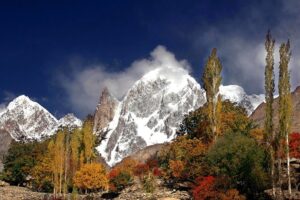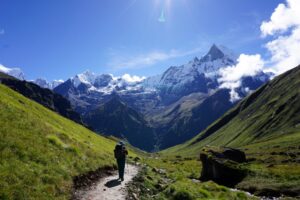Best Trekking Places in Pakistan
The mountains of Pakistan are not famous for their height solely, there is so much more to the beauty in Pakistan than what these mountains carry. Pakistan is a beautiful country and when it comes to visiting the best trekking places in Pakistan, the list will fall short. We can comprehend why Pakistan is at the top of the popular travel destination. From lush valleys to towering mountains, there is so much more to dream about when you want to go trekking in Pakistan.
The sceneries in Pakistan are mind-blowing and breathtaking as well, when you consider trekking in Pakistan, you should know that the list of places to visit is too long. However, fret no more, because we have shortlisted one of Pakistan’s most beautiful and mesmerizing places for trekking.
- Gilgit Baltistan
- Hunza Nagar
- Chitral and Ghizer
- Diamir
Now, that you are aware of the most beautiful places in Pakistan for trekking, let’s discuss their beauty alluring sceneries, and trekking sites in detail.
Gilgit Baltistan Trekking in Pakistan
Gilgit Baltistan is one of the most beautiful and mesmerizing places in Pakistan. Any tourist who comes here keeps on coming back. With the high mountains, flourishing rivers, and breathtaking scenery, Gilgit has pulled a significant number of tourists towards it. It is a perfect place for trekking and hiking, and consider a moment to sit and delve into the mesmerizing beauty of the scenery. Gilgit has cold weather throughout the year where in the summertime, night becomes colder than days and in winter, it’s all snow! The most pleasant time to visit Gilgit Baltistan is when the weather is mild, not too hot, and not too cold. During the summertime, the temperature ranges between 10℃ to 25℃, offering a sunny view of the mountains.

Hunza Nagar Trekking in Pakistan
Rather than walking outside or going on a picnic, people prefer trekking. If you’re one of those people who adore trekking and have a passion for it, then today we will discuss the best trekking places in Hunza Nagar.
Hunza Nagar has a captivating beauty that drags attention. It is an ideal location if you want to go trekking or climb the mountain for amusement. Hunza Valley is merged in the northern parts of Pakistan, formed by the Hunza rivers at an elevation of 2,430 m which is a total of 7,999 feet above sea level.

Due to its location and climate, Hunza Nagar is a very popular place among tourists, trekkers, and adventurers. In the surrounding of Hunza, several peaks rise to the height of 7,000 meters. The Hunza Nagar provides a list of high mountains that include, Rakaposhi, Ultar Sar, Bojahagur Duanasir II, Diran Peak, Ghenta Peak, and more. Hunza also carries a wide range of incident watchtowers, that are located in the heart of Ganish Village. With its peak mountains and luxurious valleys, Hunza Nagar is the perfect spot for Trekking in Pakistan.
Chitral and Ghizer Trekking in Pakistan
Chitral and Ghizer have become cherished heavens for trekking enthusiasts, attracting people from all around the world to experience their unparalleled natural beauty and cultural diversity. The enchanting landscape is punctuated by soaring peaks, lush valleys, crystal-clear rivers, and alpine meadows that seem to touch the sky. What sets this area apart is not only its’ awe-inspiring view but also its cultural mosaic.
The highest peak in the Ghizer district is Koyo Zom which is around 6,871 meters and lies at the boundary between the Ghizer district and Chitral.
As trekkers traverse the trails, they are met by friendly faces, vibrant traditions, and a sense of belonging that resonates with each step.

Unlike the other parts of the country, the temperature of Chitral is very harsh and cold. Summer is the best time to visit Chitral because the weather is pleasing and enjoyable. The same goes for Gilgit, the winter is harsh while the summer is pleasant and an ideal time to visit.
Diamir Trekking in Pakistan
Diamir offers some incredible views for trekking in Pakistan, especially in the context of the Karakoram mountain range. One of the most famous trekking places in Diamir is the Nanga Parbat camp trek. Naga Parbat is the ninth-highest mountain in the world and is known as the killer mountain due to the high fatality rate among climbers attempting its summit. The best time go to trekking in Diamir is in the summer when the weather is pleasant and the roads are accessible. However, the weather conditions in mountainous areas can be unpredictable. For it is essential to be prepared for the sudden change in the weather. As with most of the trekking, you will need to obtain the necessary permits to access the region. It is also advisable to hire a local guide or join a trekking agency that helps with logistics, accommodation, and safety.

In conclusion
Trekking in Pakistan offers a wide range of experiences that caters to adventurers, nature lovers, and those seeking to explore the country’s stunning landscape and rich cultural heritage. From the towering peaks of the Himalayas, Karakoram, and Hindu Kush, mountains range to the lush valleys and remote villages, Pakistan’s trekking opportunities are truly remarkable.
The best time of the year to visit these heavenly places in Pakistan is the summertime. From June to August when the weather is more predictable and the traits are accessible. Nonetheless, trekkers should be prepared for sudden changes in the weather and challenging conditions, especially in mountainous regions.
Trekking in Pakistan offers a wide range of opportunities to connect with nature, challenge oneself, and appreciate the raw beauty of the landscapes. It’s a journey that not only provides physical adventure but also fosters a deep appreciation for the country’s natural wonders.
FAQs
Q: Is Pakistan a safe destination for trekking?
A: While certain areas of Pakistan are considered safe for trekking, it’s important to research and stay updated on the current security situation before planning your trip. Some regions, especially those near border areas, might have travel advisories. Collaborating with local guides and trekking agencies can provide valuable insights into safe routes and areas.
Q: What are some popular trekking destinations in Pakistan?
A: Popular trekking destinations include the Karakoram Range (with peaks like K2 and Nanga Parbat), the Himalayas, the Hindu Kush Range, and the northern areas such as Gilgit-Baltistan. Specific treks include the Baltoro Glacier trek, the Nanga Parbat Base Camp trek, and the Rakaposhi Base Camp trek, among others.
Q: When is the best time for trekking in Pakistan?
A: The best time for trekking is generally during the summer months, from June to August. During this period, the weather is milder, and the trails are more accessible. However, weather conditions can still vary in mountainous regions, so be prepared for changes.
Q: Do I need special permits for trekking in Pakistan?
A: Yes, many trekking areas in Pakistan require permits. The process can vary depending on the region and specific trek you’re planning. It’s advisable to obtain the necessary permits well in advance, and sometimes you might need to go through a registered trekking agency to secure these permits.
Q: How physically fit do I need to be for trekking in Pakistan?
A: Trekking in Pakistan can be physically demanding, especially in high-altitude areas. It’s recommended to have a good level of fitness and stamina. Regular exercise and training before your trek can help you better acclimatize and enjoy the experience.
Q: Can I trek independently, or do I need a guide?
A: While some experienced trekkers might choose to trek independently, hiring a local guide or joining a trekking agency is often recommended. Local guides are familiar with the terrain, culture, and potential challenges. They can enhance your experience and ensure your safety.
Q: What should I pack for a trek in Pakistan?
A: Essential items include appropriate clothing for various weather conditions, sturdy trekking shoes, a good quality backpack, a sleeping bag suitable for the climate, a first aid kit, and high-altitude essentials like sunglasses, sunscreen, and a hat.
Q: How can I prepare for the altitude during trekking in Pakistan?
A: Gradual acclimatization is key to avoiding altitude sickness. Plan your trek itinerary with rest days and gradual ascents. Stay hydrated, avoid alcohol, and listen to your body. If symptoms of altitude sickness appear, descend to lower altitudes.
Q: What is the availability of accommodations during treks?
A: Accommodation options can vary depending on the trekking route. Some treks have basic guesthouses or camping sites, while others might involve camping in the wilderness. It’s important to research the specific trek and plan accordingly.
Q: How do I respect local cultures and customs while trekking?
A: Local cultures and traditions are an integral part of the trekking experience. Respect local customs, dress modestly, ask for permission before taking photos of people, and avoid littering. Engaging respectfully with local communities can enrich your trekking journey.


